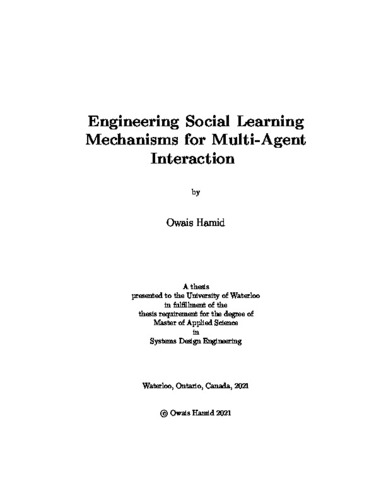| dc.contributor.author | Mateen Abdul Hamid, Owais | |
| dc.date.accessioned | 2021-09-14 20:26:40 (GMT) | |
| dc.date.available | 2021-09-14 20:26:40 (GMT) | |
| dc.date.issued | 2021-09-14 | |
| dc.date.submitted | 2021-09-03 | |
| dc.identifier.uri | http://hdl.handle.net/10012/17387 | |
| dc.description.abstract | This thesis is strongly inspired by literature on animal social learning, applying it to multi-robot as well as human-robot interaction scenarios, Social learning, which can include complex or simple social mechanisms, allow us to understand cooperation and communication in animals, giving them better chances to survive for longer and thrive as a society. For this dissertation, to translate this understanding into socially rich behavior among multi-agent robots and Human-Robot Interaction, two experiments were conducted.
The first experiment focused on how social learning might optimize cooperation among robots (in a robot 'society') for the problem of foraging. The task utilizes small and simple swarm robots to understand how such social mechanisms might play a role in establishing rules for emergent group behavior and how social rules might be engineered to gain useful effects in a group of robots. The study investigated exploratory behavior without interaction (asocial) and with interaction (social). The results from this exploratory study suggest that deterministic asocial exploration is best performed by a Spiral exploration mechanisms. However, these asocial exploration strategies are eclipsed by certain types of social reward sharing strategies as long as sharing occurs for at least half the lifetime of the robots. Sharing locations of reward caches for all time is of course the most optimal, but comes at the cost of communicating longer and hence using more energy both on the sender and receiver’s end. An analysis of a compromise strategy between completely asocial exploration and social reward location sharing is performed using strategies termed critical and conditional learning. It is found that the number of reward caches located through critical and conditional learning are intermediary to the two extremes, namely completely asocial and completely social foraging.
The second experiment sought to understand if and how other types of social learning mechanisms such as observational conditioning can facilitate social information spread to human participants. The question of whether, and to what extent, a robot can influence a human's actions is asked through a study designed to understand if emotions displayed by a robot demonstrators can influence human observers. An immersive first-person gaming experience utilizing Unity was designed where a robot demonstrator reacted either positively or negatively to an external stimulus. Objective (position of player in-game) and subjective (Questionnaire) data collected on the human participants' reactions suggests that the virtual robot agent is successful in socially transmitting information.
Through these studies, I seek to contribute to the understanding of the role simple social learning mechanisms can play in information transfer among human and robot agents, and to identify useful metrics for the detection of such social mechanisms. | en |
| dc.language.iso | en | en |
| dc.publisher | University of Waterloo | en |
| dc.subject | Multi-agent Robotics | en |
| dc.subject | Human-Robot Interaction | en |
| dc.subject | Social Learning | en |
| dc.subject | Robotics | en |
| dc.title | Engineering Social Learning Mechanisms for Multi-Agent Interaction | en |
| dc.type | Master Thesis | en |
| dc.pending | false | |
| uws-etd.degree.department | Systems Design Engineering | en |
| uws-etd.degree.discipline | System Design Engineering | en |
| uws-etd.degree.grantor | University of Waterloo | en |
| uws-etd.degree | Master of Applied Science | en |
| uws-etd.embargo.terms | 0 | en |
| uws.contributor.advisor | Dautenhahn, Kerstin | |
| uws.contributor.advisor | Nehaniv, Chrystopher | |
| uws.contributor.affiliation1 | Faculty of Engineering | en |
| uws.published.city | Waterloo | en |
| uws.published.country | Canada | en |
| uws.published.province | Ontario | en |
| uws.typeOfResource | Text | en |
| uws.peerReviewStatus | Unreviewed | en |
| uws.scholarLevel | Graduate | en |

